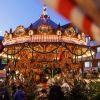German cake is an international hit
What actually is Baumkuchen? Why does it enjoy such popularity internationally? Where does its name come from? Find out all about the cult cake here.

A lot of people like eating sweet things at Christmas time. This a popular topic on social networks, too. But it’s not Spekulatius biscuits, Christmas stollen or Lebkuchen (gingerbread) that are going viral: on TikTok in particular, users are clicking millions of times on videos about Baumkuchen. How do you cut Baumkuchen correctly? Does an expensive Baumkuchen bought at a patisserie taste better than a cheap one from the supermarket? These are just some of the issues being hotly debated: Baumkuchen – a TikTok hype.
How to cut and serve Baumkuchen
In a video posted by a patisserie in the small town of Salzwedel in Saxony-Anhalt, the boss herself demonstrates the correct way to cut a Baumkuchen. In contrast to what you might expect, it is not cut through vertically from top to bottom: instead, individual layers are removed horizontally with the knife. There are no end of comments under the video. One common question is: “Huh, is that really how you cut it?”. But people are interested in what the cake costs as well – it’s much cheaper to buy at the supermarket. If you want to purchase a whole Baumkuchen, the price tag is high: it costs around 50 euros to buy one at a patisserie. So why is it so expensive? The high price is mainly due to the way the cake is made – it really is an elaborate craft. This is another reason why Baumkuchen is served as the “king of all cakes” on special occasions such as at Christmas.
Where does Baumkuchen get its name from?
The mixture is baked in several layers on a rotating roller. Whenever a new layer is applied, the mixture caramelises, creating ring-shaped layers. This is what gives the cake its name: the rings look like growth rings on a tree (Baumkuchen literally means “tree cake”).
But it’s not just TikTok that’s crazy about German Baumkuchen. It’s enormously popular in Japan. “Baumkuchen is one of the best-loved cakes in Japan,” says Hideo Kawamoto, President of the Japanese pastry manufacturing company Juchheim. In a café on Tokyo’s elegant Omotesando promenade, he serves a slice straight from the oven. It was baked according to the original recipe created by German master confectioner Karl Joseph Wilhelm Juchheim – the man Kawamoto’s company is named after. Originally from Kaub on the Rhine, it was Juchheim who brought the Baumkuchen to Japan – in unusual circumstances.
Everyone in Japan is familiar with the German speciality
In the early 20th century, Juchheim was living with his wife Elise in Qingdao, China, which was a German colony at the time. The couple ran a patisserie there. This region was occupied by Japan during the First World War. Juchheim was taken to Japan as a prisoner of war, initially leaving his wife alone in occupied Qingdao. Her husband was interned with other Germans in a camp near Hiroshima. Juchheim was allowed to bake cakes there. For a show of German craftsmanship in an exhibition hall – today’s Peace Memorial, also known as the "Atomic Bomb Dome” – he baked a Baumkuchen, a type of cake that was not known at all in Japan at the time.
After the war, the Juchheims opened their first patisserie in Yokohama. Today, 100 years later, the German Baumkuchen the couple made famous has become a Japanese classic. “Karl Juchheim wanted to give us Japanese something that would make us happy,” explains Kawamoto. And to this day, Baumkuchen still has this auspicious image in Japan. Whether for weddings, as a gift for business partners, as a snack between meals or as a souvenir – every Japanese person is familiar with Baumkuchen and the name Juchheim. The Kobe-based corporation has around 270 stores throughout the country.

